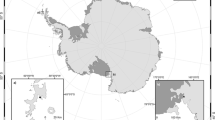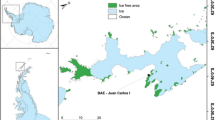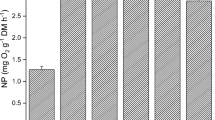Abstract
Antarctica, with its almost pristine conditions and relatively simple vegetation, offers excellent opportunities to investigate the influence of environmental factors on species performance, such information being crucial if the effects of possible climate change are to be understood. Antarctic vegetation is mainly cryptogamic. Cryptogams are poikilohydric and are only metabolically and photosynthetically active when hydrated. Activity patterns of the main life forms present, bryophytes (10 species, ecto- and endohydric), lichens (5 species) and phanerogams (2 species), were monitored for 21 days using chlorophyll a fluorescence as an indicator of metabolic activity and, therefore, of water regime at a mesic (hydration by meltwater) and a xeric (hydration by precipitation) site on Léonie Island/West Antarctic Peninsula (67°36′S). Length of activity depended mainly on site and form of hydration. Plants at the mesic site that were hydrated by meltwater were active for long periods, up to 100 % of the measurement period, whilst activity was much shorter at the xeric site where hydration was entirely by precipitation. There were also differences due to life form, with phanerogams and mesic bryophytes being most active and lichens generally much less so. The length of the active period for lichens was longer than in continental Antarctica but shorter than in the more northern Antarctic Peninsula. Light intensity when hydrated was positively related to the length of the active period. High activity species were strongly coupled to the incident light whilst low activity species were active under lower light levels and essentially uncoupled from incident light. Temperatures were little different between sites and also almost identical to temperatures, when active, for lichens in continental and peninsular Antarctica. Gradients in vegetation cover and growth rates across Antarctica are, therefore, not likely to be due to differences in temperature but more likely to the length of the hydrated (active) period. The strong effect on activity of the mode of hydration and the life form, plus the uncoupling from incident light for less active species, all make modelling of vegetation change with climate a more difficult exercise.








Similar content being viewed by others
References
Brabyn L, Beard C, Seppelt RD, Rudolph ED, Türk R, Green TGA (2006) Quantified vegetation change over 42 years at Cape Hallett, East Antarctica. Antarct Sci 18:561–572
Cannone N, Seppelt R (2008) A preliminary floristic classification of northern and southern Victoria Land vegetation (continental Antarctica). Antarct Sci 20:553–562
Clarke LJ, Robinson SA, Hua Q, Ayre DJ, Fink D (2012) Radiocarbon bomb spike reveals biological effects of Antarctic climate change. Glob Change Biol 18:301–310
Clayton-Greene KA, Collins NJ, Green TGA, Proctor MCF (1985) Surface wax, structure and function in leaves of Polytrichaceae. J Bryol 13:549–562
Convey P, Smith RIL (1997) The terrestrial arthropod fauna and its habitats in northern Marguerite Bay and Alexander Island, maritime Antarctic. Antarct Sci 9:12–26
Fowbert JA (1996) An experimental study of growth in relation to morphology and shoot water content in maritime Antarctic mosses. New Phytol 133:363–373
Gerighausen U, Bräutigam K, Mustafa O, Peter H (2003) Expansion of vascular plants on an Antarctic island, a consequence of climate change? In: Huiskes AHL, Gieskes WWC, Rozema J, Schorno RML, van der Vies SM, Wolff WJ (eds) Antarctic biology in a global context. Backhuys, Leiden, pp 79–83
Gimmingham CH, Smith RIL (1971) Growth form and water relations of mosses in the maritime Antarctic. Br Antarct Survey Bull 25:1–21
Glime JM (2007) Bryophyte Ecology. Volume 1. Physiological Ecology. Ebook sponsored by Michigan Technological University and the International Association of Bryologists. Accessed on 08 November 2011 at: http://www.bryoecol.mtu.edu/
Green TGA, Lange OL (1994) Photosynthesis in poikilohydric plants: a comparison of lichens and bryophytes. Ecol Stud 100:319–341
Green TGA, Schroeter B, Kappen L, Seppelt RD, Maseyk K (1998) An assessment of the relationship between chlorophyll a fluorescence and CO2 gas exchange from field measurements on a moss and lichen. Planta 206:611–618
Green TGA, Schroeter B, Seppelt RD (2000) Effect of temperature, light and ambient UV on the photosynthesis of the moss Bryum argenteum Hedw. in Continental Antarctica. In: Davison W, Howard-Williams C, Broady P (eds) Antarctic ecosystems: models for a wider ecological understanding. Caxton, Christchurch, pp 165–170
Green TGA, Schroeter B, Sancho LG (2007) Plant life in Antarctica. In: Pugnaire FI, Valladares F (eds) Handbook of functional plant ecology. Marcel Dekker, New York, pp 389–433
Green TGA, Brabyn L, Beard C, Sancho LG (2011a) Extremely low lichen growth rates in Taylor Valley, Dry Valleys, continental Antarctica. Polar Biol 35:535–541
Green TGA, Sancho LG, Pintado A, Schroeter B (2011b) Functional and spatial pressures on terrestrial vegetation in Antarctica forced by global warming. Polar Biol 34:1643–1656
Hill PW, Farrar J, Roberts P, Farrell M, Grant H, Newsham KK, Hopkins DW, Bardgett RD, Jones DL (2011) Vascular plant success in a warming Antarctic may be due to efficient nitrogen acquisition. Nat Clim Change 1:50–53
Huiskes AHL, Gremmen NJM, Francke JW (1997) Morphological effects on the water balance of Antarctic foliose and fruticose lichens. Antarct Sci 9:36–42
Kappen L (1993) Lichens in the Antarctic region. In: Friedmann EI (ed) Antarctic microbiology. Wiley, New York, pp 433–490
Kappen L, Breuer M (1991) Ecological and physiological investigations in continental Antarctic cryptogams. II. Moisture relations and photosynthesis of lichens near Casey Station, Wilkes Land. Antarct Sci 3:273–278
Kappen L, Valladares F (2007) Opportunistic growth and desiccation tolerance, the ecological success of the poikilohydrous strategy. In: Pugnaire FI, Valladares F (eds) Functional plant ecology. CRC, Boca Raton, pp 9–80
Kappen L, Schroeter B, Green TGA, Seppelt RD (1998a) Chlorophyll a fluorescence and CO2 exchange of Umbilicaria aprina under extreme light stress in the cold. Oecologia 113:325–331
Kappen L, Schroeter B, Green TGA, Seppelt RD (1998b) Microclimatic conditions, meltwater moistening, and the distributional pattern of Buellia frigida on rock in a southern continental Antarctic habitat. Polar Biol 19:101–106
Kennedy AD (1993) Water as a limiting factor in the Antarctic terrestrial environment: a biogeographical synthesis. Arctic Alp Res 25:308–315
Lakatos M (2011) Lichens and bryophytes: habitats and species. In: Lüttge U, Beck E, Bartels D (eds) Plant desiccation tolerance. Springer, Heidelberg, pp 65–88
Longton RE (1988) The biology of polar bryophytes and lichens. Cambridge University Press, Cambridge
Pannewitz S, Green TGA, Scheidegger C, Schlensog M, Schroeter B (2003) Activity pattern of the moss Hennediella heimii (Hedw.) Zand. in the Dry Valleys, Southern Victoria Land, Antarctica during the mid-austral summer. Polar Biol 26:545–551
Peat HJ, Clarke A, Convey P (2007) Diversity and biogeography of the Antarctic flora. J Biogeogr 34:132–146
Pintado A, Sancho LG, Blanqueri JM, Green TGA, Lazaro R (2010) Microclimatic factors and photosynthetic activity of crustose lichens from the semiarid southeast of Spain: long-term measurements for Diploschistes diacapsis. Bibl Lichenol 105:211–224
Pontailler J-Y (1990) A cheap quantum sensor using a gallium arsenide photodiode. Funct Ecol 4:591–596
Proctor MCF (2008) Physiological ecology. In: Goffinet B, Shaw AJ (eds) Bryophyte biology. Cambridge University Press, Cambridge, pp 237–268
Proctor MCF, Smirnoff N (2011) Ecophysiology of photosynthesis in bryophytes: major roles for oxygen photoreduction and non-photochemical quenching? Physiol Plant 141:130–140
Reiter R, Höftberger M, Green TGA, Türk R (2008) Photosynthesis of lichens from lichen-dominated communities in the alpine/nival belt of the Alps-II: laboratory and field measurements of CO2 exchange and water relations. Flora 203:34–46
Robinson SA, Wasley J, Popp M, Lovelock CE (2000) Desiccation tolerance of three moss species from continental Antarctica. Aust J Plant Physiol 27:379–388
Sancho LG, Green TGA, Pintado A (2007) Slowest to fastest: extreme range in lichen growth rates supports their use as an indicator of climate change in Antarctica. Flora 202:667–673
Sancho LG, de la Torre R, Pintado A (2009) Lichens, new and promising material from experiments in astrobiology. Fungal Biol Rev 22:103–109
Schlensog M, Schroeter B (2000) Poikilohydry in Antarctic cryptogams and its influence on photosynthetic performance in mesic and xeric habitats. In: Davison W, Howard-Williams C, Broady P (eds) Antarctic Ecosystems: Models for wider ecological understanding. Caxton, Christchurch, pp 175–182
Schlensog M, Schroeter B (2001) A new method for the accurate in situ monitoring of chlorophyll a fluorescence in lichens and bryophytes. Lichenologist 33:443–452
Schlensog M, Pannewitz S, Green TGA, Schroeter B (2004) Metabolic recovery of continental antarctic cryptogams after winter. Polar Biol 27:399–408
Schroeter B, Kappen L, Green TGA, Seppelt RD (1997) Lichens and the antarctic environment: Effects of temperature and water availability on photosynthesis. In: Lyons WB, Howard-Williams C, Hawes I (eds) Ecosystem processes in Antarctic ice-free landscapes. Balkema, Rotterdam, pp 103–117
Schroeter B, Green TGA, Pannewitz S, Schlensog M, Sancho LG (2010) Fourteen degrees of latitude and a continent apart: comparison of lichen activity over two years at continental and maritime Antarctic sites. Antarct Sci 22:681–690
Schroeter B, Green TGA, Pannewitz S, Schlensog M, Sancho LG (2011) Summer variability, winter dormancy: lichen activity over 3 years at Botany Bay, 77°S latitude, continental Antarctica. Polar Biol 34:23–30
Schroeter B, Green TGA, Kulle D, Pannewitz S, Schlensog M, Sancho LG (2012) The moss Bryum argenteum var. muticum Brid. is well adapted to cope with high light in continental Antarctica. Antarct Sci 24:281–291
Selkirk PM, Scotnicki ML (2007) Measurement of moss growth in continental Antarctica. Polar Biol 30:407–413
Seppelt RD, Türk R, Green TGA, Moser G, Pannewitz S, Sancho LG, Schroeter B (2010) Lichen and moss communities of Botany Bay, Granite Harbour, Ross Sea, Antarctica. Antarct Sci 22:691–702
Smith RIL (1996) Terrestrial and freshwater biotic components of the western Antarctic Peninsula. In: Hofmann EE, Ross RM, Quetin LB (eds) Foundations for ecological research west of the Antarctic Peninsula, Antarctic Research Series, vol 70. American Geophysical Union, Washington, pp 15–59
Smith RIL (2003) The enigma of Colobanthus quitensis and Deschampsia antarctica in Antarctica. In: Huiskes AHL, Gieskes WWC, Rozema J, Schorno RML, van der Vries SM, Wolff W (eds) Antarctic biology in a global context. Backhuys, Leiden, pp 234–239
Turner J, Bindschadler RA, Convey P, Di Prisco G, Fahrbach E, Gutt J, Hodgson DA, Mayewski PA, Summerhayes CP (2009) Antarctic climate change and environment. SCAR, Cambridge
Walton DHW (1984) The terrestrial environment. In: Laws RM (ed) Antarctic ecology. Academic, London, pp 1–60
Xiong FS, Mueller EC, Day TA (2000) Photosynthetic and respiratory acclimation and growth response of Antarctic vascular plants to contrasting temperature regimes. Am J Bot 87:700–710
Zotz G, Schweikert A, Jetz W, Westerman H (2000) Water relations and carbon gain are closely related to cushion size in the moss Grimmia pulvinata. New Phytol 148:59–67
Acknowledgments
B.S. and M.S. gratefully acknowledge financial support by Deutsche Forschungs-Gemeinschaft (DFG SCHR 473/4-3). R.I.L. Smith, Cambridge, UK, is thanked for introduction to the field site at Leonie Island. Logistical and technical support was kindly provided by British Antarctic Survey (Cambridge, UK). Pete Convey, Cambridge, UK, is thanked for critical comments which substantially improved the manuscript. Magdalena Biszczuk, British Antarctic Survey Mapping and Geographic Information Centre, is thanked for preparing the map. T.G.A.G. was supported by Ramon y Cajal Fellowship at Vegetal II, Farmacia, Universidad Complutense, Madrid, Spain, and by FRST grant—Understanding, valuing and protecting Antarctica’s unique terrestrial ecosystems: Predicting biocomplexity in Dry Valley ecosystems, during the writing of this paper. All required permits for field work and plant experimentation were obtained from the appropriate Antarctic authorities.
Author information
Authors and Affiliations
Corresponding author
Additional information
Communicated by Hermann Heilmeier.
Rights and permissions
About this article
Cite this article
Schlensog, M., Green, T.G.A. & Schroeter, B. Life form and water source interact to determine active time and environment in cryptogams: an example from the maritime Antarctic. Oecologia 173, 59–72 (2013). https://doi.org/10.1007/s00442-013-2608-9
Received:
Accepted:
Published:
Issue Date:
DOI: https://doi.org/10.1007/s00442-013-2608-9




